Portrayal of Women
Women’s Profiles
Pulido's Sephardi Female Correspondents
Conclusions
In 1904, the Spanish Senator Ángel Pulido Fernández (1852-1932) launched a campaign to create closer bonds between Spain and the Sephardi Jews. The campaign consisted of his interventions in the Spanish Senate, his lectures, several articles published in the press and, above all, his two published books Los israelitas españoles y el idioma castellano (The Spanish Israelites and the Castilian Language) and Españoles sin patria y la raza sefardí (Spaniards without a Homeland and the Sephardi Race).1
Pulido, a doctor, was a representative of the ideological movement called Regeneracionismo (“regenerationism,” a term taken from the vocabulary of medicine, where regeneration was used as the opposite of corruption), which developed in Spain in the late nineteenth and early twentieth centuries. Regenerationism advocated for the Spanish nation to regenerate itself by liberating itself from its decline through modernization, education and the promotion of economic activity.
In the Spanish Senate, Pulido represented a Liberal party. His political mentor was the historian and journalist Emilio Castelar (1832-1899), founder of a moderate Republican party called Partido posibilista (possibilist party). Castelar was a prominent figure in Spanish politics from the time of the revolution that dethroned Queen Isabella II in 1868; he became President of the First Spanish Republic in 1873-1874.
It is often considered that Pulido’s political and pedagogical campaign was the origin of philosephardism, a Spanish ideological movement in favor of the Jews of Hispanic origin. But, in fact, in his campaign Pulido used and reworked some of the ideas about Sephardi Jews that were being expressed from the 1870s in several Spanish liberal periodicals connected to Regenerationism, including the newspaper El Globo, founded by Emilio Castelar and the journal Revista de Geografía Comercial, whose director was Joaquín Costa, one of the most important figures of the Spanish Regenerationist movement.2
However, one new element that Pulido introduced to Spanish philosephardism made his campaign radically different from anything that had preceded it: he developed a wide network of correspondents from different countries of the Sephardi diaspora with whom he exchanged ideas and information through letters. These letters were partially reproduced in his two books mentioned above, and especially in the second one.
As Martine Lemoine suggests, Pulido created something that resembles a social network using the available tools that existed at the turn of the twentieth century.3 The majority of the members (i.e., the correspondents) of this network managed by Pulido, never met each other in person and accessed the network from geographically remote locations. The network had global dimensions as it included participants from Europe, Asia, Africa and America, who simultaneously provided advice, gave their opinions and discussed different topics, occasionally refuting each other, or expressing their agreement or disagreement. This network created by Pulido moreover served as an unofficial forum for the transnational Sephardism of his time.
As in today’s social networks, images played a fundamental role in that forum. The correspondents sent photographs to Pulido, including pictures of significant places in their communities and, above all, photographs of themselves and of people from their close circle of social relations.
Much has been written about Pulido’s correspondents, especially about some of them, such as Haim Bejarano and Abraham Cappon.4 Yet, the important number of women that appear in Pulido’s books has thus far been overlooked by scholars. The information provided by Pulido about these women is often scarce: it includes a mere photograph with a brief caption. Yet, other women are described in more detail, while at least three of them actively exchanged letters with Pulido. This article is dedicated to them.
BACK
Portrayal of Women
In Pulido’s two books, over two hundred people are mentioned, including supporters and critics of his philosephardic campaign.5 Approximately 150 of those mentioned are Sephardi Jews from different parts of the world. Fifty of these people are women, 48 of them are identified by their names and two others appear without names in two photographs that illustrate the traditional clothing of Eastern and Moroccan-Sephardi women, respectively. The rest of the individuals mentioned are non-Sephardi intellectuals and politicians from Spain and other countries, including several Ashkenazi Jews.
The visibility that Pulido grants to women is rather exceptional in the context of his time. It would be difficult to come across any other book published in Spain by a male author at the turn of the twentieth century in which almost a third of the people mentioned are women. How these women are portrayed, and why Pulido chose them over others, calls for particular consideration. Most significantly, the photographs reproduced in both books were chosen by the correspondents themselves.
At the beginning of the twentieth century the exchange and collection of personal photographs was a common social practice among both men and women of the middle class. The massive distribution of photography in Europe and America began with the visiting card, a printed item created to serve as an instrument of social relations. As early as 1851, Luis Dodero, a Marseilles photographer, placed his portrait on his own visiting cards. In 1854 André-Adolphe Disdéri, a Parisian photographer, patented the carte de visite portrait photographe, a visiting card with a photographic portrait pasted on one of its sides.6 These photographic visiting cards enjoyed an extraordinary success and led to the production not only of thousands of visiting cards with portraits of private individuals, but also others with photographs of prominent figures. These visiting cards were sold in huge numbers, exchanged in social circles and collected in albums. About a decade later, cabinet portraits, which had a larger format (approximately the size of a postcard), began to be produced and also achieved great success. As Helmut Gernsheim has pointed out, “No longer was photography an art for the privileged: it has become the art for the million.”7
Although photographs appear in reduced size in Pulido’s book, most of the originals were most likely either visiting cards or cabinet portraits.
Moreover, we know that Pulido sent his own photograph to several of his correspondents, as they thanked him for sending them his portrait.8 These pictures reflect two matching interests: on the one hand, they reveal the kind of image of Sephardi Jews that Pulido wished to transmit in Spain; and on the other hand, they provide us with a sense of the image that Sephardi correspondents themselves wanted to transmit to the Spanish senator and the Spanish public, as they were well-aware he was planning on disseminating this information in the Spanish media.9
Both parties moreover shared similar interests: Pulido connected with the bourgeois Sephardi classes that he considered refined, educated, modern and enterprising as he believed these Sephardi Jews were capable of promoting the economic regeneration of Spain, which had just lost the last colonies of its old empire and was in a state of economic and political decline. At the same time, his Sephardi correspondents were interested in presenting themselves to Pulido (and, through him, to the Spanish public) as modern and advanced.10
A significant feature of the photographs concerns the clothing items that Pulido’s Sephardi correspondents chose to wear for the pictures they shared with him. Dress style underwent an important change at the turn of the twentieth century, both in the Ottoman Empire and in North Africa.11 First men, and soon after that women, adopted Western ways of dressing. Indeed, of the 50 women that appear in Pulido’s books, 41 posed dressed in Western attire, usually wearing hats and garments of the latest fashion trends of the bourgeoisie of their respective countries.
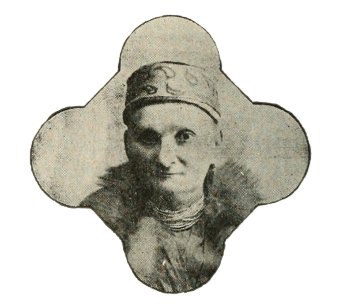
Pulido, Españoles, 556.
The other nine photos depict women wearing traditional attire. One of these images was moreover a fairly well-known postcard,12 accompanied in the book by the following caption: “Spanish Israelite from Thessaloniki. A popular type” (Pulido, Españoles, 25).13 Three women from Sarajevo pose wearing a traditional Balkan dress: Sunca Salom, the wife of the president of the Sephardi community of Sarajevo (Pulido, Españoles, 556; fig. 1); and Ricca Pinto and Gracia Sumbul, who appear together in a photo taken in the studio of a professional photographer (Pulido, Españoles, 326; fig. 2).
Three other women wear the berberisca costume, typical of Sephardi weddings in Morocco14: one is an anonymous woman who was included to illustrate the traditional clothing of Moroccan Jewish women with the caption “Jewish Spanish woman from Tetuan” (Pulido, Españoles, 255); the second is Esther Benayón from Tetuan (Pulido, Españoles, 156; fig. 3); and the third is Raquel Pilo from Seville (fig. 4) who not only participated in the welcome reception held by the Jewish community of Seville in honor of King Alfonso XIII, when he visited the city in 1904, but also composed a laudatory poem for that occasion, which Pulido reproduced in his book.15
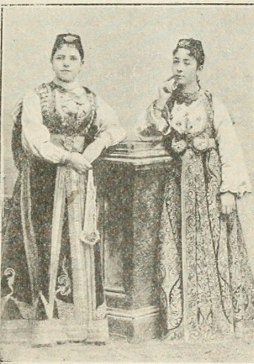
Pulido, Españoles, 326
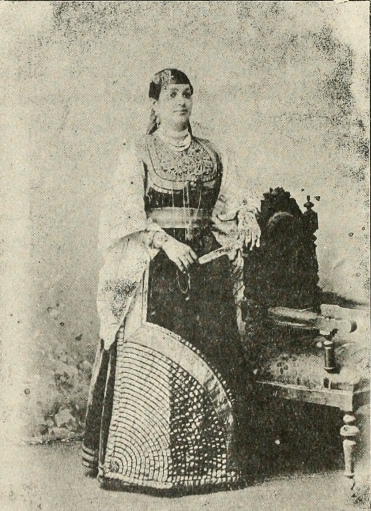
Pulido, Españoles, 164
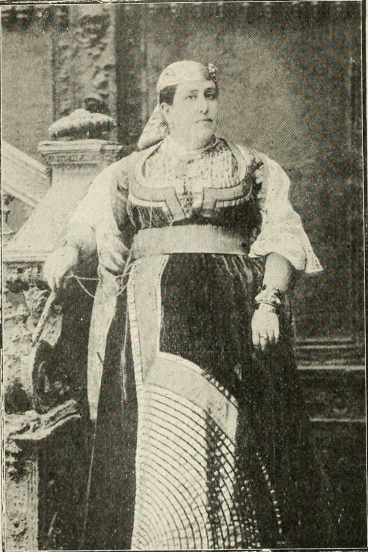
Pulido, Españoles, 342
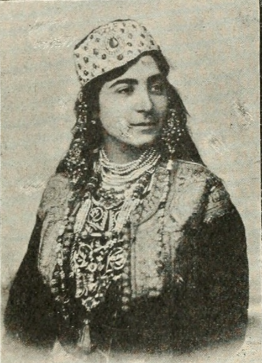
Pulido, Españoles, 252.
Judith Toledano, from Oran, also poses wearing traditional attire, which appears to be a version of the berberisca wedding outfit. The caption that accompanies the picture simply indicates she is “a distinguished lady of Oran (daughter of Mr. Solomon Levy)” (Pulido, Españoles, 252; fig. 5), without any mention of whether it was her usual garment or a dress for a special occasion.
Another interesting example is that of Victoria Barisac, who chose to appear in an Ottoman dress typical of traditional Muslim Turkish attire (Pulido’s caption reads: “distinguished Sephardi Mademoiselle of Constantinople, in Turkish dress”, 248; fig. 6). The custom of being photographed in traditional Muslim-Turkish clothing was also practiced in the late nineteenth and early twentieth centuries by other Westernized Sephardi Jews of the Ottoman empire, both men and women, who usually wore Western-style clothes in their daily lives.16
Similarly to Barisac, Micca Gross Alcalay, one of Pulido’s most active correspondents, mailed him two of her photos: one of herself dressed in Western attire (fig. 7) and another, apparently taken when she was in the prime of her youth, “dressed in a villager costume of Styria [Austria]” (Pulido, Españoles, 24; fig. 8).
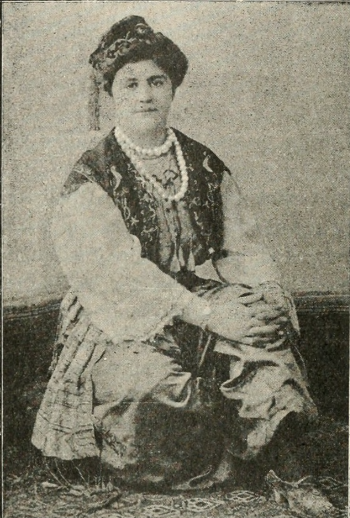
Pulido, Españoles, 248.
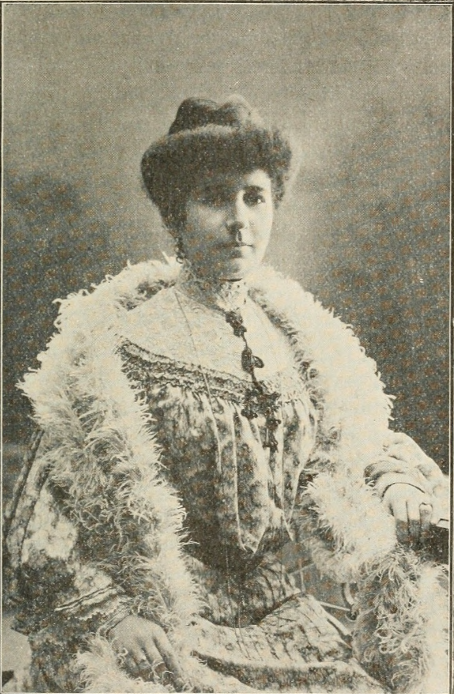
Pulido, Españoles, 321.
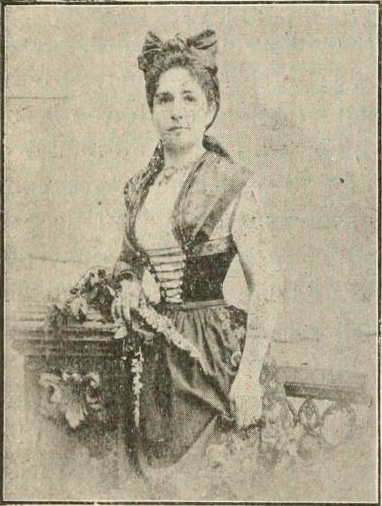
We have no information about why Micca Alcalay chose to send Pulido a photograph of herself dressed as a peasant from Styria, but it is worth recalling that at this time, Bosnia (Micca Alcalay’s birthplace), Trieste (where she lived when she became Pulido’s correspondent) and Styria were all part of the Austro-Hungarian empire.
BACK
Women’s Profiles
The captions that accompany the pictures are quite revealing. Even today, the information published in the media about women tends to focus on their physical appearance (for example, their beauty or elegance). This is the case even when their social relevance is unconnected to any activity directly related to their physical appearance as in the case of female athletes, politicians or wives of heads of state, to name a few. In the early twentieth century, this trend was even more prominent and praising female beauty was almost a sine qua non, especially when the information was accompanied by an image. Pulido’s captions, however, generally focus on different attributes of these women, rather than on female beauty. There are only two cases in which he included references to their beauty: “Rosa de Toledo, a distinguished and beautiful mademoiselle of Adrianopolis” (Pulido, Españoles, 137; fig. 9); and “Matilde Salom, a pretty and graceful mademoiselle, member of the elite of the Spanish Israelite community of Sarajevo” (Pulido, Españoles, 324).
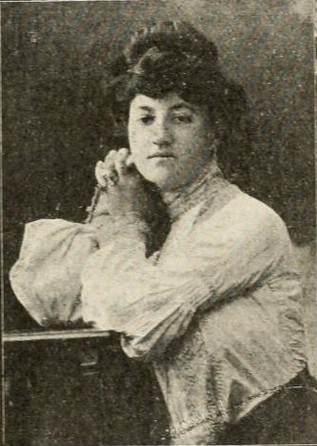
Pulido, Españoles, 137.
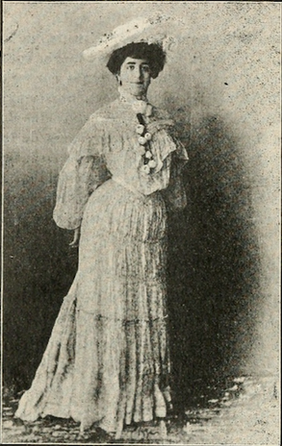
Pulido, Españoles, 536
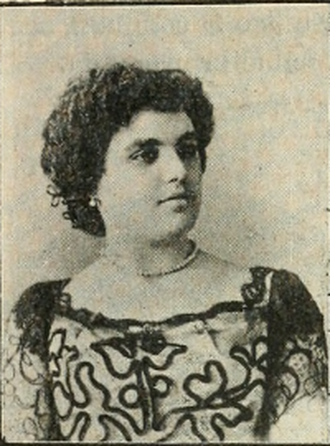
Pulido, Españoles, 351
In most cases, the adjective Pulido applied to these women (both married and single) is not “beautiful,” but “distinguished,” which does not refer to their physical appearance, but to their refinement and their social status as members of the upper class. For example, he describes several of these women in the following manner: “Miss Luna Benasayag, a distinguished young lady, member of the high society of Tangier” (fig. 10); “Miss Simita Benatar, a distinguished Spanish Israelite from Gibraltar” (fig. 11); “Mrs. Simi Bensimon, a distinguished lady of Mazagán (a Sephardi colony of Tangier [sic]),” “Mrs. Gimol Lasry and Miss Esther Lasry. An ornament [sic] of the most distinguished society of Tangier,” “Mrs. Chiquinha Salgado, a distinguished lady of the Sephardi community of Tetuan, she lives in Para (Brazil),” etc. (Pulido, Españoles, 536, 351, 486, 251 and 486, respectively).
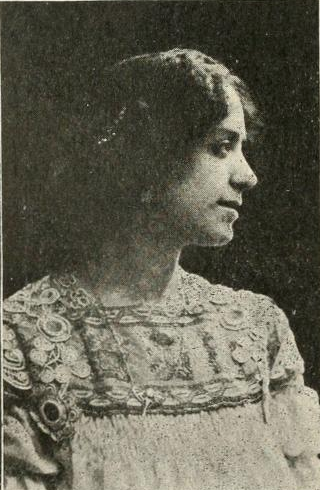
Pulido, Españoles, 294.
Often, the presentation of these women by Pulido notes their intellectual qualities, their educational background, their artistic activities, or their active role in society (albeit not reduced to their Jewish communities) including their participation in social events, cultural associations or charities: “Blanca Canetti, wife of M. Presente, a distinguished Spanish Israelite from Burgas (Bulgaria). She speaks six languages and the most eminent people of the city frequent her palace”; “Miss Lisita H. Nahon, a treasurer of the ‘Armonía’ Society and piano soloist at charity events (Tangier)”; “Miss Fina Haïm, a Spanish Israelite, a talented artist who won an award in sculpture” (fig. 12); María Haim “a distinguished Sephardi mademoiselle, an outstanding student at the School of Arts and Industries”; “Miss Rosa Haim, distinguished for her abilities and knowledge”; “Miss Clara Haim, appreciated for her oil paintings”; “Miss Rahma Toledano. A distinguished writer and a secretary of the ‘Armonía’ Society”; “Reyna Alcalay Salom, a distinguished lady. President of the Charitable Association of Hebrew Ladies ‘Humanidad’ (Sarajevo)”; “Ms. Meriam (María) Benasayag. Efficient Secretary of the ‘La Maternelle’ charity association. Admired for her charity work (Tangier)” (Pulido, Españoles, 26, 484, 294, 295, 297, 298, 188, 335 and 506, respectively). It is interesting to give some thought to why these women appear in Pulido’s book, as only three of them appear to have been active correspondents (an issue to which I will return) who exchanged letters with him. The other women were included at the suggestion of other correspondents who provided their photos and some information about them.
First of all, it is useful to make a comparison between these women based on their marital status since marriage played an important role in determining the social status of women in the early twentieth century. One would imagine that the majority of women included in the book were married and were the wives of Pulido’s male correspondents. Nonetheless, while there are a total of 21 married women—to whom Pulido either referred as a dama (a lady), or placed the title doña, equivalent to lady, or Mrs., before their respective names—25 of these women were single. In this case, before their respective names, Pulido placed the titles Señorita, Srta. or Sta. equivalent to Mademoiselle, or Miss. There is also a photograph of a girl, Sofía Azriel, as well as a widow, “Mrs. Rebeca Elvira Athias, widow of Moisés Salcedo” (Pulido, Españoles, 266). Therefore, the number of single women, some of whom were his most active correspondents, exceeds, although not by much, that of married women.
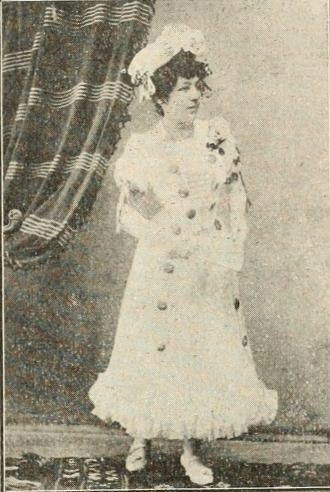
Pulido, Españoles, 29.
The relationship of these women with Pulido’s other correspondents is stated only in a few instances. For example, four of them were wives of male correspondents: Tamarad Ascher was the wife of Lázaro Ascher (Bucharest); Blanca Canetti was married to M. Presente (Bulgaria); Preciada Pinto was the wife of D.A. Pinto (Tangier), and Sunca Salom was wed to the president of the Sarajevo community (Pulido, Españoles, 394, 26, 264, 556, respectively). Furthermore, three women were daughters of male correspondents: Buca Canetti, photographed with a girl named Sofía Azriel, was the daughter of D.H. Canetti (Romania); Judith Toledano was the daughter of Salomón Levy (Orán), and Carolina Carmona’s father was Enrique Carmona (Tetuán) (Pulido, Españoles, 401, 252, 434). Perla Levy (Nice, France) is mentioned as being the wife of Jacques Coriat and the daughter of Solomon Levy (Pulido, Españoles, 469), while Juana Sak or Siaky (she appears alternatively with both names) is stated to be “the niece of the Illustrious pedagogue Moisés Fresco from Constantinople” (Pulido, Españoles, 29; fig. 13).
Even though the relationships between the different correspondents are not always expressly revealed in Pulido’s books, the coincidence between some surnames may indicate the existence of local family networks. For example, there are several men and women from Morocco whose last name is Toledano who probably were part of the same family; and the same can be surmised regarding several individuals named Serfaty or Nahon.
BACK
Pulido's Sephardi Female Correspondents
As noted at the beginning of this essay, only three women appear as active correspondents who exchanged letters with Ángel Pulido: Rahma Toledano, from Tangier; Fina Haim, from Berlin, and Micca Gross Alcalay, born in Sarajevo, who lived in Trieste.
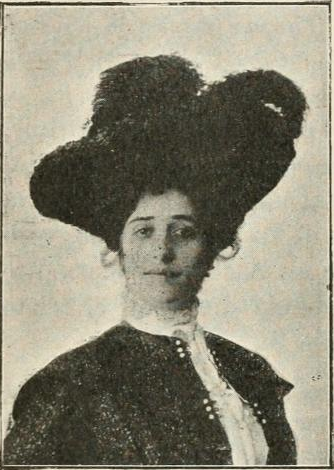
Pulido, Españoles, 188.
Rahma Toledano (fig. 14) was most probably the only female correspondent whom Pulido got to meet personally. It is possible that they met each other for the first time during Pulido’s trip to Tangier in 1904, and they certainly saw each other on various occasions in Madrid during Rahma Toledano’s trips to the Spanish capital where she stayed at the luxurious Palace hotel. Pulido used to visit her there accompanied by his granddaughters. Although Pulido was over fifty and Rahma was in her twenties, it seems that they established a close friendship based on mutual admiration, despite the age difference.17
From her early youth and throughout her life, Rahma Toledano was a prominent figure of the Jewish community of Tangier. She received a Western education in Tangier, first in a Catholic school and then in the school of the Alliance Israélite Universelle (and presided over its alumni association for a while). She also published numerous articles in Spanish and French in various newspapers in Morocco, Spain, France and Argentina. Moreover, she was a Zionist activist, serving as a delegate to the Women’s International Zionist Organization of London, and she collaborated with several charities in Tangier.18 In his 1905 book, Pulido refers to Rahma Toledano in the following manner:
She stands out in Tangier for her talent for writing, her grace and her kindness. She is the secretary of many charitable societies and has published reports and memoirs, as well as delicate and highly poetic articles in El Eco Mauritano, one of the newspapers published in Tangier. She and her two sisters belong to that highly educated and charming Israelite society of Tangier [...] The letter, as one will note, is written in elegant Spanish and is a model of tenderness and Spanishness.19
The newspaper El Eco Mauritano (The Mauritian Echo) was published in Spanish in Tangier between 1886 and 1930. It was founded by two Sephardi men, Isaac Toledano and Isaac Laredo, and a Gibraltarian journalist of Spanish origin and British nationality, Agustín Lúgaro.20 According to Abraham Laredo, Rahma Toledano was Isaac Toledano’s sister21 and it is highly probable that she was responsible for providing Pulido with a series of photographs of women from the same family. One of these women was named Amelia Laredo de Toledano (Pulido, Españoles, 532), which suggests that the families of the two Sephardi men who founded El Eco Mauritano were probably related by marriage.
Pulido reproduces several fragments of a letter sent to him by Rahma Toledano which complicate Pulido’s emphatic statements about her Spanishness and her love for Spain. In these letters, Toledano maintains a more ambivalent attitude towards her Spanish roots and expresses gratitude for her French education:
Deeply moved by the reading of your book Los israelitas y el idioma castellano, I have not been able to resist the impulse to express to you, within the possibilities that my modest knowledge of the language allows me to do, all the admiration that your work has sparked in me. We, the Jewish youth, educated in the schools of the Alliance Israelite in which the teaching is mainly in French, have learned the Castilian language in our homes and through reading. However, they have taught us, in French, how to think, but not how to feel. In the schools of the Alliance we have received intellectual drive and have built up principles of character. There we have become aware of our personality; there we have developed a latent feeling of dignity and self-esteem, which had been repressed for so long; lastly, there we have formed our minds; and for these benefits we owe this institution eternal gratitude.22
Toledano then proceeds to proclaim her sentimental affection for Spain (implicitly opposed to the intellectual education provided by France):
But our heart is purely Spanish because of our tenderness, sensitivity, sincere and disinterested affection, our indolent predisposition to dream, our spirit of sacrifice draped in that atmosphere of sentimentality. That is why, upon reading your book brimming with nobility and elevated intentions, I have felt the gratitude of those who witness the disappearance of a painful impression.23
She then recalls the source of that painful impression:
Your highly noble campaign not only rehabilitates Spain, but also succeeds in erasing the infamous vision of a cruel and inquisitorial Spain. When I was a little girl, as a result of one of those coincidences caused by curiosity and desire to learn, the bloody and inhumane history of the Inquisition fell into my hands. Hidden in a tiny corner, I read horrified about such scary events and through my young imagination, I saw vaguely, as in a nightmare, autos-da-fé, innocent creatures condemned to thousands of tortures, young women putting up with unprecedented horrors inflicted upon their bodies. My entire soul then objected, rebelled and sobbed with indignation. Like ghosts from hell, I saw the monstrous figures of Torquemada and Ignacio de Loyola, and from the bottom of my tender little girl’s heart I cursed their crimes. Later, time, reflection and study partly erased the impression that this reading engraved in my soul. And in the same way I always hated the heartless men of that bloody century, I also came to appreciate contemporary liberal and progressive men, and I came to love Spain, that conciliatory Spain, free of guilt for the past.24
In her letter, rather than expressing her “Spanishness,” in the manner expressed by Pulido, Toledano conveys her deep gratitude for the intellectual training and moral dignity she received in the Alliance Israelite schools, in opposition to an image of Spain that combines two widespread stereotypes: the identification of Spain as a fanatical and intolerant country, the cradle of the Inquisition; and the image of an indolent, dreamy country, a common cliché largely fostered by nineteenth-century Western European (and in particular French) Orientalist literature.
The second female correspondent, Fina Haim, was a teenager who sent Pulido several letters which included information about the Sephardi Jews who had settled in Berlin, including her own family, who were merchants from Constantinople:
Our adorable little friend belongs to a distinguished Spanish family from the East. Her parents have the best carpet and tapestry store in Berlin, and she has three other sisters, no less charming than Fina, named María, Clara and Rosa, whose photographs embellish this book.25
Despite her young age, Fina Haim’s letters indicate remarkable philological finesse. For example, in commenting on the linguistic attitude of the Sephardi Jews of the Ottoman Empire who maintained the use of Spanish and did not learn the language of the countries in which they lived for centuries, she states:
Yesterday, speaking of the Spanish Jews, I heard one saying something I had already heard many times: “It is deeply ungrateful that the Spanish Jews did not embrace the language of the country that had welcomed them with such generosity at the time of the expulsion from their homeland.” It seems to me that there is some truth in this claim. But, on the one hand, the beauty of the language, with its folktales and songs, excuses us, and on the other hand, it is also the only legacy of our ancestors. A magnificent legacy that we have conserved in the way only a religion is preserved among a people.26
Likewise, when Fina sent Pulido a text of a traditional ballad “written down as she heard it from her grandmother, whom she had asked to sing Spanish legends” (Pulido, Españoles, 295), she had enough sensibility to copy the text exactly as it was sung by her informant, without falling into the temptation of fixing it or introducing her own corrections to it, something that was common among the pioneers of traditional song collecting. Fina’s philological finesse, moreover, appeared superior to that of Pulido’s, who, with regard to the dialectal features of the text commented with a certain attitude of superiority: “It seems clear that it [the poem] is corrupt.”27
Yet, undoubtedly, Pulido’s most active female correspondent was Micca (or Maria, or Marietta) Gross Alcalay, a Sephardi woman from Sarajevo who married an Ashkenazi Jew and moved to Trieste, which at that time was part of the Austro-Hungarian Empire.28 When she initiated her contact with Pulido in March of 1904, after reading an article of his in La Ilustración Española y Americana (an important Spanish periodical published in Madrid between 1869 and 1921, which she read regularly), Micca Gross Alcalay was in her forties. From that moment on, a very intense relationship of affection and mutual admiration was established between the two. They carried on a continuous and dynamic correspondence over a period of one year, exchanging two to three letters per week.
Micca was Pulido’s only correspondent in Trieste and, therefore, all of the information he received about the Sephardi Jews from this city originated with her. Moreover, thanks to Micca, Pulido got in touch with some of his Bosnian and Serbian correspondents, such as Benko Davicho, who, together with his brother Haim, translated works of Spanish literature into Serbian that were performed at the National Theater in Belgrade (Pulido, Españoles, 321).
In his 1905 book, Pulido reproduces extensive parts of some of Micca’s letters to him, highlighting her intelligence and knowledge, her femininity and her “good manly judgment” (buen juicio varonil). He describes her as: a “distinguished and very intelligent lady”; an “intelligent and beautiful friend”; an “intelligent collaborator of our work”; and emphasizes that she was a polyglot, as she spoke four languages: German, Italian, French and “Spanish” (that is, Judeo-Spanish).
Micca Gross Alcalay’s letters, deal with quite diverse topics and display dialectal features of Bosnian Judeo-Spanish, despite the editor’s corrections and her own efforts to accommodate her language to modern Spanish: she provides information about the Sephardi Jews of Trieste, as well as those of her native Bosnia; and on the impact of Austro-Hungary in the process of enlightenment and modernization of the Balkan Sephardi Jews. She comments on her readings of Spanish literature, which included works such as Don Quixote, the writings of José de Echegaray, Emilio Castelar’s speeches, and the theater play Electra by Benito Pérez Galdós that had been performed in Spain only three years earlier, in 1901, and caused wide controversy due to its feminist and anticlerical content. She also reflects on the characteristics of Judeo-Spanish, which was her mother tongue, and expresses her feeling of pride to have been able to read so much in Spanish and “perfect” her knowledge of it, to the point that she can pass for a Spaniard. She even recounts how on one occasion two Spanish women thought she was a native of Madrid. She also sent Pulido Sephardi ballads and songs, descriptions of folk customs and of children’s games.
While I cannot analyze in detail all of the particular features of Gross Alcaly’s letters in this essay, I would like to highlight two particular aspects: her sense of humor, present in all of her letters; and her critical attitude regarding the situation of women and, especially, concerning the arranged marriages that were common among the Sephardi Jews of Bosnia of the time and that she herself had personally experienced.
Hence, in one of her letters, Micca describes a game that was played by girls which included the singing of a ballad about a gentleman who is looking for a wife. The gentleman asks a “Moorish King” to give him one of his daughters as a wife, which leads to a discussion between them concerning the conditions. Micca makes the following comment:
I call it the preparandum for marriage, because who among us did not know that one day a similar “gentleman” had to come to ask for the hand of the “Moorish king’s daughter”? [...] When I recall with how much eagerness the one who played the role of the father [in the game] begged the gentleman to take one of the daughters, I start laughing, because in real life it happens in the same way: “please, come back, come back sir,” and then they would add: “and don’t ask for much money [as dowry].”29
In another one of her letters she explains to Pulido the different ways of greeting among Sephardi women, describes marriage customs, and shares songs that were sung at Sephardi weddings:
The professional women singers with their tambourines show up at the girl’s or bride’s house and sing in such a manner that everyone starts crying a lot if the girl goes abroad upon marrying, as was my case:
My daughter, think carefully
before you go:
on the paths you take
you won’t find brothers or relatives.
Make your husband’s family your own
and don’t make them detest you,
you pretty girl
The melody is Arabic and as sad as the lyrics of the song are, it is a very necessary admonition for the girl to “make your husband’s family your own” and “don’t make them detest you.”30
In her comments one can also detect a certain melancholy typical to those “married from far away lands”:
These stories of passion and great love are good for tales and ballads. They are a fiction. They don’t really exist in real life. This is how marriages happen: when a girl reaches the age that her parents consider appropriate for her to marry, one day the father, more serious than usual, enters your little room, a nest of your sweet dreams, and tells you: “My daughter, so-and-so has asked for your hand in marriage, do you accept?” The girl thinks: “anyway, a girl has to marry, one or another, it makes no difference.” She replies to her father: “whatever you consider best.” I don’t know what the girl gains by marrying, or rather, what she loses. The perfect man, the god of her dreams, becomes a material object, assai materiale as a Dalmatian woman, a friend of mine, would tell me. The marriage occurs later through the custom of being always united to a man, with whom you are to spend all your days and to whom you become accustomed, as happens with everything that belongs to you. I know you’ll tell me that suicides because of love, and adultery, happen. Most candidates in the first case (suicide) are insane and would take their own lives for any reason. The second option (adultery) shows a personality weakness, a lack of pride. A woman who has dignity, thinks: “Why should I be a toy in men’s hands; they look at us without any mercy as flowers, take us, smell us and then throw us in the trash?” Don’t take me for your enemy, not at all, I’m only revealing the real life that women have to accept unlike the poetry of their childhood.31
The correspondence with Micca Gross Alcalay left a strong and long-lasting impression on Pulido. Almost twenty years had passed since their correspondence when in 1923 Pulido published his book Micca. Homenaje a la mujer hebrea to honor his old epistolary friend who was still present in his memory. In this book, Pulido openly declares to have been platonically in love with her. Furthermore, the book, which incidentally starts with a dedication to another of his female correspondents, Rahma Toledano, reveals that Micca Gross Alcalay was no longer alive when Pulido’s second book appeared in 1905. Micca passed away that very same year, on May 18, as a consequence of a domestic accident. Apparently, she had received a copy of the book in which she had collaborated so enthusiastically and in which part of her letters were reproduced, but she was not able to read it because she was already on her deathbed.32
Pulido inevitably reproduces some of the stereotypes about women typical of his time. For example, while praising the culture, intelligence and progressive mentality of his correspondent Micca Gross Alcalay, he also praises her dedication as a housewife and her absolute lack of pretensions and arrogance, an attitude expected of women: “she lives and cultivates her little home with the simplicity of a good bourgeoise, reads a lot, judges with perfect social sense and has no literary pretenses and even fewer of becoming a writer.”33
When he explains what his intention was by including photographs of women in his book, he declares that he wants to show the similarity between Sephardi and Spanish women. He does not present Sephardi Jews as “exotics” or “Orientals,” but as identical to Spaniards, an idea that is coherent with his romanticized theory about the Sephardi Jews as “Spaniards without a homeland.” But he nonetheless succumbs to the stereotype of mentioning modesty as the most prominent trait of these Sephardi women:
Overcoming women’s natural reluctance and modesty, we have brought to our book the portraits of distinguished and honorable ladies and mademoiselles, subjecting them to unusual publicity, though not ̶take note!—to exhibit them as if they were samples in a shop window, or as if they were actresses or professional fashion models, but to prove with their honest physiognomies [...] the affirmation that I have made so many times before: that they are identical to women we can see in our own homes, relationships, and social environment.34
Notwithstanding these stereotypes, and considering the standards of his time, Pulido pays unusual attention to women, who make up almost a third of Sephardi Jews mentioned in the book. In most photographs, women appear elegantly dressed in the style of the bourgeoisie, and the comments he writes to accompany these images do not focus mainly on their beauty, but rather on their education and intellect (their studies, their command of languages, their artistic abilities), their social success and participation in benevolent societies for the well-being of their community:
They speak three or four languages, they adorn themselves with the piano and singing, they participate in social charities and represent a powerful driving force in the education and regeneration of their children.35
Pulido’s attitude towards women in general, and towards Sephardi women in particular, was undoubtedly influenced by his personal relationship with some Spanish feminists of his time, and principally with three women who were part of three different generations: Concepción Arenal (1820-1893), Concepción Gimeno de Flaquer (1850-1919) and Carmen de Burgos (1867-1932).
According to Martine Lemoine, Concepción Arenal was a moral reference in Pulido’s formation: “Three great figures had an influence on his professional and political raining: Concepción Arenal for his social sensitivity, Dr. Velasco for his scientific training and Emilio Castelar for his political training.”36 Concepción Arenal was a lawyer, writer and contributor to several newspapers, as well as a reformer of the Spanish penitentiary system. She promoted the establishment of humanitarian associations in Spain, such as the Red Cross (founded in Switzerland in 1863) and the Catholic charitable organization Society of San Vicente de Paul (founded in Paris in 1833). She also supported the Asociación para la Enseñanza de la Mujer (Association for the Instruction of Women), an educational project founded in 1870.37
Carmen de Burgos, younger than Pulido, was in several ways a successor to his work. A teacher, writer and press collaborator (she used the pseudonym of Colombine), de Burgos addressed the issue of the condition of women in numerous articles, books and lectures.38 Undoubtedly influenced by Pulido’s campaign, she promoted the publication of articles relating to Sephardi culture in the magazine Revista Crítica, founded by her in 1908,39 and later in the magazine Prometeo. She also had a significant role in the foundation of the Alianza Hispano-Israelita association.40 Pulido mentions Carmen de Burgos and reproduces a photograph of her on page 10 of Españoles sin patria, in the acknowledgments section of the book.
Less known than the previous two women is Concepción Gimeno de Flaquer, a woman of the same generation as Pulido, to which he dedicates a few paragraphs in his book. Pulido states that the qualities of the Sephardi women featured in his book might inspire Concepción Gimeno to write a book:
Our admired friend Mrs. Concepción Gimeno de Flaquer, who has written such beautiful books about women in general and about famous women, would find here very appealing reasons to write a superb work worthy of our times.41
Concepción Gimeno collaborated in numerous magazines and newspapers, founded the magazine La Ilustración de la Mujer and in 1877 she dedicated the essay entitled La mujer española. Estudio acerca de su educación y sus facultades intelectuales (The Spanish woman. A study about her education and intellectual faculties) to king Alfonso XII. She was also a member of the Masonic lodge for women Las Hijas del Sol (The daughters of the sun).42
Some of the qualities Pulido had highlighted about Sephardi women relate to the concerns expressed by these Spanish feminists. In particular, the interest in the education and training of women, especially the young ones (which would explain the high percentage of single women who appear in Pulido’s book), or the active participation of women in society through charitable work. He also echoes the reflections on problems affecting women (arranged marriages, lack of freedom to make their own decisions) communicated by his correspondent, Micca Gross Alcalay. Pulido also applauds women who publicly express their opinions through the press (as in the case of Rahma Toledano), in a manner similar to that of his Spanish feminist friends. And throughout his book he made visible a significant number of Sephardi women about whom we only know what Pulido wrote about them, as there is no information about them in other known sources.
BACK
Conclusions
In his book Españoles sin patria y la raza sefardí (1905), Ángel Pulido shares part of his correspondence with Sephardi Jews from all over the world. To date, discussion of Pulido’s Sephardi correspondents in the academic literature has in the main referred almost exclusively to men. However, a closer reading of Pulido’s book sheds light on the importance Pulido granted to Sephardi women. Almost a third of approximately 150 Sephardi Jews mentioned in these books are women.
It seems that only three of these women were active as correspondents who exchanged letters with Pulido. Their personal profiles regarding their age, education, birthplace and place of living are rather different. Nevertheless, they had one feature in common: they all belonged to the upper-middle class of their respective communities. These women are: Rahma Toledano, a young writer from Tangier, who was a member of a family of intellectuals and journalists; Fina Haim, a teenager who lived in Berlin with her parents, who were traders originally from the Ottoman Empire; and Micca Gross Alcalay, a lady in her forties and a member of the bourgeoisie of Trieste (part of the Austro-Hungarian Empire at that moment), who was born in Sarajevo where she lived until she got married. Pulido published parts of their letters which show that these women were: intelligent, well educated, socially and intellectually active and fully aware of their Sephardi identity. He also reproduced their letters explaining the problems that women of their time faced in their social circles, especially in the case of Micca Alcalay.
With regard to the other women who appear in these books, Pulido only published their photographs along with captions in which he signals some of their attributes. In these captions, he pays particular attention not so much to women’s beauty or elegance, but to their education and their active role in their social environment, as well as within their respective Jewish communities. Pulido employs their pictures to reinforce his romanticized idea that the Sephardi Jews were “Spaniards without a homeland.” He suggested that these Sephardi women were no different from Spanish women either in their physical traits, or in their way of dressing or lifestyle. Moreover, being highly educated, polyglots and actively involved in associations devoted to fine arts and charitable work, they could serve as examples and role models for Spanish women. Although at times Pulido resorts to certain gender stereotypes typical of his era, he nonetheless pays unusual attention to women in these books, to an extent that is unique to any single book written by a male Spanish author at the turn of the twentieth century.
Pulido’s attitude towards women cannot be understood without taking into account his friendships and the admiration he felt for some of the leading Spanish feminists of his time, who also insisted on the importance of the education of women and the need for them to play an active role in the society. Particularly important was the influence that three Spanish feminists, belonging to three different generations, had over him. Concepción Arenal, thirty years older than Pulido, was an inspiring person who raised social awareness in Pulido, in the same way Emilio Castelar had raised political awareness in him. Concepción Gimeno de Flaquer was almost of the same age of Pulido. He speaks of her with admiration, praising her books and her articles about the situation of women. Carmen de Burgos (Colombine) was fifteen years younger than Pulido and in some way she became his disciple, continuing Pulido’s activities in favor of a mutual approximation between the Sephardi Jews and Spain.
BACK
[1] Ángel Pulido Fernández, Intereses nacionales. Los israelitas españoles y el idioma castellano (Madrid: Sucesores de Rivadeneyra, 1904; Barcelona: Riopiedras, 1992); Ángel Pulido Fernández, Intereses nacionales. Españoles sin patria y la raza sefardí(Madrid: E. Teodoro, 1905; Granada: Universidad, 1993). Biographies of Pulido: Manuel L. Ortega, El doctor Pulido (Madrid: Editorial Ibero-Africano-Americana, 1922) and Ángel Pulido Martín, El Dr. Pulido y su época (Madrid: n.p., 1945). On Pulido’s campaign and its repercussion, see Michael Alpert, “Dr. Angel Pulido and philo-Sephardism in Spain,” Jewish Historical Studies 40 (2005): 105-119; Martine Lemoine,El Dr. Pulido y su época: La causa sefardí(Madrid: Hebraica Ediciones, 2018); Alisa Meyuhas-Ginio, “El encuentro del senador español Dr. Ángel Pulido Fernández con los judíos del Norte de Marruecos,” El Prezente. Studies in Sephardic Culture 2 (2008): 111-125; Alisa Meyuhas-Ginio, Between Sepharad and Jerusalem. History, Identity and Memory of the Sephardim (Leiden-Boston: Brill, 2014), 248-288. I am very grateful to Zeljko Jovanovic for reading a draft of this paper and for his helpful suggestions.
[2] Jacobo Israel Garzón, “Joaquín Costa, la Revista de Geografía Comercial y los judíos,” Raíces. Revista judía de cultura 55-56 (2003): 31-34; Paloma Díaz-Mas, “El judeoespañol en la prensa española de la Restauración: informaciones en el diario El Globo,” inLengua, Llengua, Llingua, Lingua, Langue. Encuentros filológicos (ibero)románicos. Estudios en homenaje a la profesora Beatrice Schmid, eds. Yvette Bürki, Manuela Cimeli and Rosa Sánchez (München: Peniope, 2012), 190-202. For Castelar’s attitude towards the Jews, see Nitai Shinan, “Emilio Castelar y los judíos,” Miscelánea de Estudios Árabes y Hebraicos, Sección Hebreo 65 (2016): 101-118.
[3] Lemoine, El Dr. Pulido, 66.
[4] For example, Marie-Christine Bornes-Varol, “Hayim ben Moshe Bejarano, maskil, lecteur et collaborateur de presse,” in La presse judéo espagnole, support et vecteur de la modernité, eds. Rosa Sánchez and Marie-Christine Bornes Varol (Istanbul: Libra Kitap, 2013), 281-294; and Beatrice Schmid, “ ‘Por el adelantamiento de la nación.’ Las ideas lingüísticas de Abraham A. Cappon,” inLos sefardíes ante los retos del mundo contemporáneo: identidad y mentalidades, eds. Paloma Díaz-Mas and María Sánchez-Pérez (Madrid: CSIC, 2010), 99-112.
[5] For more information about some of the central correspondents with Pulido and his campaign, see Paloma Díaz-Mas, “Repercusión de la campaña prosefardí del senador Ángel Pulido en la opinión pública de su época,” inEspaña y la Cultura Hispánica en el Sudeste Europeo (Atenas: Embajada de España-Instituto Cervantes, 2000), 326-341.
[6] A digitized version of some of the visiting cards by Disdéri is available in the Digital Library of the Spanish National Library, “Disdéri (1819-1889),” accessed December 10, 2020,http://bdh.bne.es/bnesearch/Search.do?field=todos&text=+Disd%C3%A9ri+%281819-1889%29. In his lifetime, Disdéri was reputed to be the richest photographer in the world, and he extended his business by opening photographic studios in Toulon, London and Madrid.
[7] On the carte de visite as photograph format see Helmut Gernsheim, A Concise History of Photography (New York: Dover Publications, 1986; first revised edition London: Thames and Hudson, 1971), 55-57.
[8] For example, Lazaro Ascher, from Bucharest (see Pulido, Españoles, 393).
[9] A very different case is the photographic representation of the Sephardi Jews of Bosnia in the book by Moritz Levy Die Sephardim in Bosnien (1911), studied by Mirjam Rajner, “Visualizing the Past: The Role of Images in Fostering the Sephardic Identity of Sarajevo Jewry,” Sefarad 79 (2019): 265-295.
[10] On the social and cultural milieu of Pulido’s correspondents, see Paloma Díaz-Mas, “Corresponsales de Ángel Pulido e informantes de Menéndez Pidal: dos mundos sefardíes,” in Los trigos ya van en flores. Studia in Honorem Michelle Débax, eds. Jean Alsina and Vicent Ozanam (Toulouse: Université de Toulouse-Le Mirail, 2001), 103-116.
[11] A description of the traditional style of clothing of the Eastern Mediterranean Jews (specifically of those from Thessaloniki) can be found in Michael Molho’s, Usos y costumbres de los sefardíes de Salónica (Madrid-Barcelona: CSIC, 1950), 46-47 and 94-95. On the progressive abandonment of traditional clothing in favor of Western dress in Turkey, see Fatma Koç and Emine Koca, “The Clothing Culture of the Turks, and the Entari (Part 1: History),” Folk Life: Journal of Ethnological Studies 49, no. 1 (2011): 10-29.
[12] For example, the same postcard is reproduced in Yanis Megas, Souvenir. Images of the Jewish Community. Salonika 1897-1917 (Athens: Kapon Editions, 1993), 34. Megas’ book is a compilation of postcards with images of Thessaloniki printed in the late nineteenth and the early twentieth centuries, most of them offering an orientalist and exotic vision targeting Western travelers that visited the town. The caption “Souvenir de Salonique Costume de Dame Israélite” (which does not appear on the image reproduced by Pulido) is printed on top of the postcard reproduced by Megas.
[13] Hereinafter references to Pulido’s Españoles are indicated in parentheses.
[14] For the traditional clothing of Moroccan Jews in the late nineteenth and early twentieth centuries, see José Manuel Fraile Gil, “La indumentaria sefardí en el Norte de Marruecos. El tocado y la ropa de cada día,” Revista de Dialectología y Tradiciones Populares 59, no. 2 (2004): 43-92. For the berberisca Sephardi wedding dress and its meaning as an identity element, José Luís Sánchez Sánchez, “The Sephardi Berberisca Dress, Tradition and Symbology,” Datatèxtil 37 (2017): 37-54. https://www.raco.cat/index.php/Datatextil/article/view/329309/419895, accessed December 10, 2020.
[15] For more information about the Jewish community of Seville and its reception for Alfonso XIII during his visit in 1904, see Pulido, Españoles,342-346; José Antonio Lisbona, Retorno a Sefarad. La política de España hacia sus judíos en el siglo XX (Barcelona: Riopiedras, 1993), 26-27; and Isidro González, Los judíos y España después de la expulsión. Desde 1492 hasta nuestros días (Córdoba: Almuzara, 2014), 175-176.
[16] For this use, its identity connotations and similar practices among other religious and cultural minorities of the Ottoman Empire, see Julia Phillips Cohen, “Oriental by Design: Ottoman Jews, Imperial Style and the Performance of Heritage,” The American Historical Review 119, no. 2 (April 2014): 364-398.
[17] Pulido, El Dr. Pulido, 240.
[18] Isaac Laredo, Memorias de un viejo tangerino (Madrid: C. Bermejo, 1935), 265-266. Laredo repeatedly refers to her as “Miss,” thirty years after Pulido’s book, which might suggest that she probably never married, something uncommon for women of her time. See also Abraham Laredo, Les noms des juifs du Maroc. Essai d’onomastique judéo-marocaine (Madrid: CSIC, 1978), 618.
[19] “Sobresaliente en Tánger por su talento de escritora, su gracia y su bondad. Es secretaria de muchas Sociedades y ha publicado informes y Memorias, artículos delicados y de alta poesía en El Eco Mauritano, uno de los periódicos que se publican en Tánger. Pertenecen, ella y sus dos hermanas, a esa cultísima y simpática sociedad israelita tangerina [...] La carta, redactada en elegante castellano, como se puede apreciar, es un modelo de ternura y españolismo” (Pulido, Españoles, 188).
[20] Laredo, Memorias, 243-245.
[21] Laredo, Les noms des juifs, 616-618.
[22] “Profundamente emocionada por la lectura de su libro Los Israelitas y el idioma castellano no he podido resistir al impulso de manifestarle, en los términos en que mis modestos conocimientos del idioma me permiten hacerlo, toda la admiración que su obra me ha sugerido. Educados los jóvenes judíos en las escuelas de la Alianza Israelita, donde la enseñanza es principalmente francesa, aprendemos el idioma castellano por el uso familiar y por la lectura. Sin embargo, en francés nos han enseñado a pensar, pero no a sentir. En los bancos de las escuelas de la Alianza, hemos recibido intelectual impulso y recogido principios de carácter. Allí hemos cobrado conciencia de nuestra personalidad; allí se ha desarrollado el sentimiento latente de dignidad y propia estimación, por tanto tiempo comprimido; allí, en fin, se ha formado nuestro cerebro; y por estos beneficios debemos a dicha institución gratitud eterna” (Pulido, Españoles, 188-189).
[23] “Pero nuestro corazón es puramente español, por la ternura, la sensibilidad, la afección sincera y desinteresada, por la indolente predisposición a soñar, por el espíritu de sacrificio y por esa atmósfera de sentimentalismo con que se envuelve. Por eso, al leer su libro, rebosante de nobleza y elevadas miras, he sentido la gratitud del que ve desvanecerse una impresión dolorosa” (Pulido, Españoles,188).
[24] “Su campaña de Vd. elevadísima no solo rehabilita a España, sino que logra borrar la infanda visión de una España cruel e inquisidora. Cuando niña, por una de esas casualidades provocadas por la curiosidad y el afán de conocer, vino a mis manos la historia sangrienta e inhumana de la Inquisición. Escondida en un rinconcito, leía con espanto tan tremendos acontecimientos, y a través de mi imaginación infantil, veía confusamente, como en una pesadilla, arder los autos de fe, condenar a mil torturas a inocentes criaturas, perpetrar horrores inauditos en cuerpos de mujeres jóvenes. Mi alma entera entonces protestaba, se sublevaba y sollozaba de indignación. Entreveía como fantasmas del infierno las figuras monstruosas de Torquemada e Ignacio de Loyola, y desde el fondo de mi tierno corazón de niña maldecía sus horrores. Luego el tiempo, la reflexión, el estudio borraron en parte la impresión que en mi alma dejó grabada esa lectura, y así como odié siempre a los hombres sin entrañas de ese siglo de sangre, supe también estimar a los hombres contemporáneos, liberales y progresistas, y amé a España, a la España conciliadora, irresponsable del pasado” (Pulido, Españoles, 188-189). Rahama Toledano here commits a mistake by considering Ignacio de Loyola a member of the Inquisition, when neither he nor the Jesuit Order he founded in 1534 had any participation in the inquisitorial processes, which in fact were led by another religious order, that of the Dominicans.
[25] “Nuestra adorable amiguita pertenece a una distinguida familia española oriunda de Oriente. Sus padres poseen el mejor almacén de alfombras y tapices que hay en Berlín, y tiene otras tres hermanas, no menos encantadoras que Fina, llamadas María, Clara y Rosa, con cuyos retratos embellecemos este libro” (Pulido, Españoles, 295).
[25] “Ayer, hablando de los judíos españoles, oí, como ya muchas veces, que uno dijo: —Es grande ingratitud la de los judíos españoles que no tomaron la lengua del país que los recogió con tanta generosidad en tiempo de la expulsión de su patria.—Me parece que ya tienen un poco de razón al decir esto. Pero de una parte nos dispensa la hermosura de la lengua con sus consejas y cantitas [sic, instead canticas], y de otra parte que ella era la única herencia de nuestros padres. Una herencia magnífica que conservamos como se conserva solamente una religión en un pueblo” (Pulido, Españoles, 49).
[27] On the role of Fina Haim and Micca Gross Alcalay as keepers and collectors of Sephardi oral tradition, see Paloma Díaz-Mas, “Folk Literature among the Sephardic Bourgeois Women at the Beginning of the Twentieth Century,” European Journal of Jewish Studies 3, no. 1 (2009): 81-101.
[28] Her maiden name was Alcalay and Gross was her married name.
[29] “Yo lo llamo el ‘preparandum’ del matrimonio, porque cuál de nosotras no sabía ya que un día tiene que venir el más o menos ‘caballero’ a pedir la mano de la ‘hija del rey moro’ [...] Cuando recuerdo con cuanto anhelo llamaban los padres de ocasión a los caballeros que se les lleve alguna hija me río, porque en realdad no es de otro modo; tornad, tornad caballero y luego se ajunte: no pidéis mucho dinero” (Pulido, Españoles, 79).
[30] “A casa de la joven, o novia, vienen las cantaderas de profesión con sus panderas y cantan como sigue, que hacen derramar muchas lágrimas si la niña se casa para irse al extranjero, como fue mi caso: ‘Hija, antes que te vayas, /mira bien y para mientes, /por los caminos que irás,/ no hay hermanos ni parientes. /A los ajenos aparienta,/no te des a borecer, /hija de buen parecer’. La melodía es árabe y triste como su letra, pero es una monición muy necesaria a la niña de ‘hacer a los ajenos parientes’ y no ‘darse a borecer’ ” (Pulido, Españoles, 259).
[31] “Esas cosas de pasiones y grandes amores son buenas para cuentos y romances. Son una ficción. En realidad, no existen en la vida. Es ansí como se hacen los matrimonios: cuando la niña llega en la edad que sus padres deciden casarla, un día os entra el papá más serio que de costumbre, en vuestro cuartito, nido de dulces sueños, y os dice: Hija, fulano te pide por esposa ¿le quieres? La niña se pensa; pues que es precisa casarse, o sea uno, o otro, es indiferente. Responde al padre “como a Vd. mejor paresca”. Yo no sé que yo le diga lo que gana la niña en el matrimoño, o mejor lo que pierde; el ideal del hombre, el Dios de sus sueños, llega a ser un objeto material, assai materiale me decía una amiga dálmata. El matrimoño se hace más tarde con la costumbre de estar siempre unida al hombre, con el cual tiene de pasar sus días y al cual se afecciona como a todo lo que nos apartiene. Vd. me dirá, que suceden los suicidios por amor o el adulterio. Los candidatos al primo ya son lo más alienados y se toman la vida por cualquier razón; lo segundo es debilidad de carácter, mancansa de orgullo. La que tiene orgullo pensa: “¿por qué que sea yo el juguete del hombre, el cual sin piedad nos contemplan por flores, nos cojen, nos uelen y tiran a la basura?”. No me tome Vd. por enemiga de ustedes, no, sólo le expono la vida real que tienen que acceptar las mujeres en cambio de la poesía de su niñez” (Pulido, Españoles, 327-328).
[32] See Pulido, Mica [sic]. Homenaje a la mujer hebrea (Madrid: Editorial Ibero-Africano-Americana, 1923), 19-21.
[33] “vive y cultiva su hogarcito con la sencillez de una buena burguesa, lee mucho, juzga con perfecto sentido social, y no tiene pretensiones de literatura, cuanto menos de publicista” (Pulido, Españoles, 322).
[34] “Venciendo naturales y pudorosas resistencias [de las mujeres], hemos traído a nuestro libro los retratos de distinguidas y honorables señoras y señoritas, sometiéndolos a una publicidad inusitada, no --¡cuidado!—para exhibir escogidos tipos de escaparate, como si se tratara de mostrar actrices y bellezas profesionales a la moda, sino para documentar con fisonomías honestas [...] esa afirmación tantas veces hecha, de que son las que vemos en nuestros hogares propios, en nuestras relaciones, en nuestro ambiente social” (Pulido, Españoles, 520).
[35] “Hablan tres y cuatro idiomas, se adornan con el piano y el canto, intervienen en organizaciones sociales benéficas, y representan una fuerza impulsiva poderosa en la educación y regeneración de sus hijos” (Pulido, Españoles, 258).
[36] “Tres grandes figuras tuvieron una influencia en su formación profesional y política: Concepción Arenal por su sensibilidad social, el Dr. Velasco por su formación científica y Emilio Castelar por su formación política” (Lemoine, El Dr. Pulido, 26). Dr. Velasco mentioned in the quote is Pedro González de Velasco (1815-1882), doctor, anatomist and anthropologist; Pulido published a biography of him in 1894. See Miguel Ángel Puig-Samper, “Pedro González de Velasco,” in DB~e-Diccionario Biográfico Español (Madrid: Real Academia de la Historia), http://dbe.rah.es/biografias/11049/pedro-gonzalez-de-velasco. Accessed December 10, 2020.
[37] A summary of her biography, with bibliographic references, in María José Lacalzada de Mateo, “Concepción Arenal Ponte,” in DB~e-Diccionario Biográfico Español (Madrid: Real Academia de la Historia), http://dbe.rah.es/biografias/7741/concepcion-arenal-ponte. Accessed, December 10, 2020.
[38] See Blanca Bravo Cela, “Carmen de Burgos Seguí,” in DB~e-Diccionario Biográfico Español (Madrid: Real Academia de la Historia), http://dbe.rah.es/biografias/4656/carmen-de-burgos-segui. Accessed December 10, 2020.
[39] Ángela Ena Bordonada, “Revista Crítica, una revista literaria fundada por Carmen de Burgos Colombine,” in Escritoras españolas en los medios de prensa. 1868-1936, eds. Ivana Rota and María del Carmen Servén Díez (Sevilla: Renacimiento, 2013), 95-116.
[40] María Belén Hernández González, “Carmen de Burgos, defensora de la comunidad sefardita internacional,” Revista Internacional de Culturas y Literaturas 22 (2019): 122-138.
[41] “Nuestra admirada amiga doña Concepción Gimeno de Flaquer, que tan hermosos libros ha escrito acerca de la mujer, y las mujeres célebres, hallaría aquí muy sugestivos motivos para escribir una soberbia obra digna de nuestros tiempos” (Pulido, Españoles, 258)
[42] On the Masonic lodges for women in Spain, see the monographic issue of the magazine Cultura masónica 36 (2019), dedicated to Masonería y feminismo.
Paloma Díaz-Mas is Research Professor at the Consejo de Investigaciones Científicas (CSIC) in Madrid. For more than ten years she has been directing a project about Sephardic culture at the CSIC’s Center of Humanities and Social Sciences, “The Sephardim as they see themselves and their relationships with Spain.” She has published, among others, the books Mujeres sefardíes lectoras y escritoras, siglos XIX-XX (2016), co-edited with Elisa Martín Ortega. She has also created, with her research group, the webpage Sefardiweb http://sefardiweb.com/. She is also a well-known writer, the author of several novels and short stories for which she has received the Herralde Prize and has been a finalist for the National Literature Prize and the Premio de la Crítica. Her latest works are Lo que olvidamos (2016) and the non-fiction narrative book El pan que como (2020).